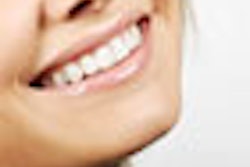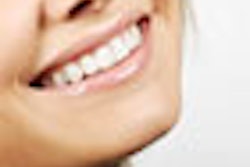
With the increasing desire for superwhite smiles, at-home dentist-supervised tooth bleaching has become quite common.
To increase the longevity and effectiveness of whitening, manufacturers of tray-based systems for home bleaching have increased the carbamide peroxide concentration in their products.
Now a new study from Brazil has found that a higher carbamide peroxide (CP) concentration does not increase the longevity of the whitening effect of at-home tooth bleaching agents or the resulting tooth shade level (Journal of the American Dental Association, September 2009, Vol. 140:9, pp. 1109-1117).
The same whitening effect can be seen up to one year postbleaching independent of the bleaching agent's concentration, said lead author Flavio Fernando Demarco, D.D.S., Ph.D., an associate professor in the departments of operative dentistry and epidemiology at Federal University of Pelotas, in a DrBicuspid.com interview.
Randomized controlled trial
Dr. Demarco and his colleagues conducted a randomized controlled clinical trial to evaluate the longevity of the whitening effect of two custom tray bleaching systems -- one with a 10% carbamide peroxide concentration (CP10) and the other with a 16% concentration (CP16) -- at one year.
“The use of higher carbamide peroxide concentrations ... is not necessary to obtain a better whitening effect.”
— Flavio Fernando Demarco,
D.D.S., Ph.D.
They divided 92 participants into two equal-sized groups according to the carbamide peroxide concentration of their tray. Participants used the tray for two hours daily for three weeks. After this treatment, the researchers evaluated tooth shade with a shade guide and a spectrophotometer at baseline, one week, six months, and one year after bleaching.
At the one-year recall appointment, both groups had significantly lighter teeth. The group treated with CP16 had lower tooth shade values than the CP10 group at the one-week and six-month evaluations, but the researchers did not observe this difference at the one-year recall.
Previous studies have shown that higher-concentration agents can whiten teeth faster than lower-concentration ones, but similar effects can be achieved with both high- and low-concentration agents after a few weeks.
Dentists should avoid using concentrations higher than 10% CP for at-home tooth bleaching due to the increased risk of developing tooth sensitivity, Dr. Demarco said.
Although more than 50% of participants in both treatment groups did not report any kind of tooth sensitivity, the participants treated with 16% CP group experienced more tooth sensitivity in the first and third weeks of treatment than those treated with 10% CP, he said.
"Our findings have demonstrated that the use of higher carbamide peroxide concentrations for at-home tooth bleaching is not necessary to obtain a better whitening effect or an increase of its longevity when compared to 10% CP use," Dr. Demarco said.
"The American Dental Association (ADA) published guidelines for the acceptance of dentist-dispensed home-use tooth bleaching products. On the basis of the results of published clinical trials, these guidelines ensure the benefits, safety, and effectiveness of carbamide peroxide applied in a tray at a concentration of 10%," the authors concluded.
Avoid 16% carbamide peroxide?
Does that mean that dentists should instruct patients to avoid products with a carbamide peroxide concentration of 16%, since both concentrations yield the same results in the long run?
Munther Sulieman, B.D.S., from the department of oral and dental science at the University of Bristol Dental School in the U.K., who has also done research on this topic (Journal of Esthetic and Restorative Dentistry, March 2006, Vol. 18:2, pp. 93-100), does not think so.
"It means that the current volume of research and safety data is mostly on 10% CP, hence its recommendation," Dr. Sulieman explained. "With time and more research data on 16% CP, it too would then become an accepted concentration."
Increased whitening speed is the main benefit of using the 16% concentration, he noted.
Because it is the accepted standard, Dr. Sulieman's policy is to start with 10% CP where possible unless time is an issue. However, it is important to be aware of the increased risk of sensitivity when using higher concentrations, he warned.
"The final shade change is independent of the concentration of bleaching agent, with time as the dominant variable," Dr. Sulieman concluded in his study. "Higher concentrations of CP that have not been investigated previously may be a treatment option for aesthetic improvement of shade where time is at a premium, but caution must be exercised in view of the possible increased incidence of sensitivity."
Copyright © 2009 DrBicuspid.com



















